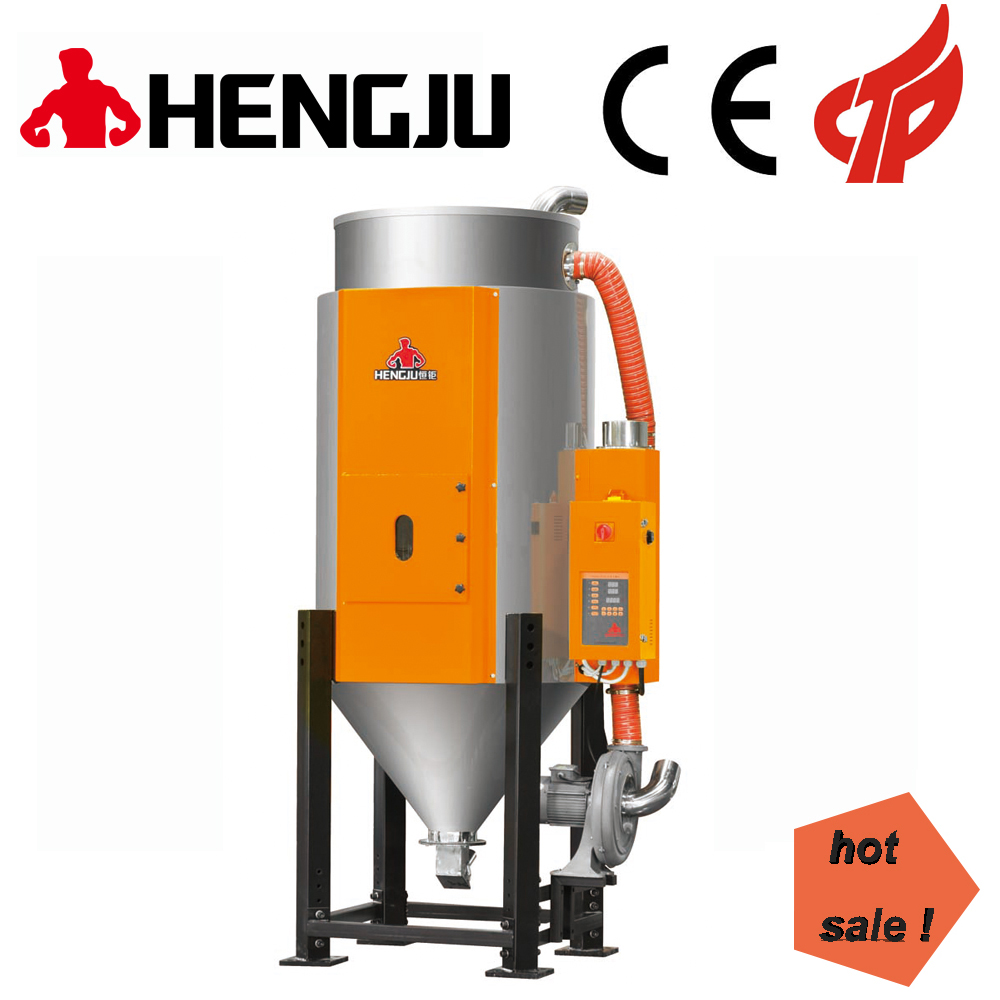plastic dryer |
|
|
 |
plastic dryer |
How are plastics classified, for example, ABS, PA, PP, PET, etc., and how to distinguish |
source:Plastic pellet dryer Author:plastic dryer time:2020年09月21日 14:41:46 |
| plastic dryer,
Dehumidifying dryer,
Plastic pellet dryer,
plastic Dehumidifying dryer
simply put: The most essential difference between plastic and rubber is that plastic deforms when deformed, while rubber deforms elastically. In other words, plastic is not easy to restore to its original state after deformation, while rubber is relatively easier. The elasticity of plastic is very small, usually less than 100%, while rubber can reach 1000% or more. Most of the plastic molding process is completed, and the product process is completed; and the rubber molding process needs to be vulcanized. Plastic and rubber are both polymer materials, which are mainly composed of carbon and hydrogen atoms, and some contain a small amount of oxygen, nitrogen, chlorine, silicon, fluorine, sulfur and other atoms. They have special properties and special uses. At room temperature, Plastic is solid, very hard, and cannot be stretched and deformed. Rubber is not high in hardness, elastic, and can be stretched to become longer, and it can be restored to its original shape after stopping the stretching. This is caused by their different molecular structures. Another difference It is plastic that can be recycled and reused many times, while rubber cannot be recycled directly. It can only be processed into reclaimed rubber before it can be used. The shape of plastic at more than 100 degrees to 200 degrees is the same as that of rubber at 60 to 100 degrees. The shape is similar. Plastic does not include rubber. To be more complicated: Broadly speaking, rubber is actually a kind of plastic, and plastic includes rubber. Now introduce it in detail General industrial double-sided adhesives can be divided into two categories: acrylic adhesive and rubber adhesive. And these two categories can be divided into two types: base material and no base material (with base material: add a layer of cotton to the glue to enhance the amount and strength of the double-sided tape itself, no base material: Pure glue to ensure the transparency of double-sided tape). Because the main body of the rubber rubber system is CR, it is used in rubber products, and it can easily react with the rubber vulcanization system to turn yellow. Therefore, lighter colored rubber products are all made of double-sided tape with a substrate in the acrylic adhesive system (the same type of double-sided tape, whether with or without substrate, is distinguished by its own gel thickness.  The composition of plastic includes the following parts: There are single-component and multi-component plastics. Single-component plastics only contain synthetic resins that are essential in plastics. For example, plexiglass is made of a single-component polymethyl methacrylate plastic. In addition to synthetic resins, most plastics also have fillers, hardeners, colorants and other additives. This is multi-component plastic. 1. Synthetic resin Almost all plastics use synthetic resins. Resin is the most important component in plastics, which acts as an adhesive and can bond other components of the plastic into a whole. Although adding various additives can change the properties of plastics, resin is the fundamental factor that determines the type, performance and use of plastics. Commonly used resin types in plastic decoration materials are: Polyethylene (PE), polyvinyl chloride (PVC), polystyrene (PS), phenolic (PF), urea-formaldehyde (UF), epoxy (EP), polyester (PR), polyurethane (PU), polymethyl Methyl acrylate (PUMA), silicone (SI), etc. According to the changes that occur when heated, synthetic resins can be divided into two types: thermoplastic resins and thermosetting resins. (1) Thermoplastic resin: It has the properties of being softened by heat and hardened by cooling, and does not have a chemical reaction. This property can be maintained no matter how many times the heating and cooling are repeated. The molecular structure of all thermoplastic resins is linear. It includes all polymerized resins and partially condensed resins. Thermoplastic resins include: polyethylene, polyvinyl chloride, polystyrene, polyamide, polyformaldehyde, polycarbonate, polyphenylene ether, polysulfone, rubber, etc. The advantage of thermoplastic resin is that it is easy to process and form and has high mechanical energy. The disadvantage is poor heat resistance and rigidity. (2) Thermosetting resin: The resin undergoes chemical changes after heating, and gradually hardens into shape. It will not soften or dissolve when heated. The molecular structure of thermosetting resin is body type, which includes most of the condensation resin. The advantage of thermosetting resin is high heat resistance and not easy to deform under pressure. The disadvantage is poor mechanical properties. Thermosetting resins include phenolic, epoxy, amino, unsaturated polyester and silicone ether resins. 2. Filler Fillers can improve and enhance the performance of plastics. For example: adding fibers can improve the mechanical strength of plastics; adding asbestos can enhance the heat resistance of plastics; adding mica can enhance the electrical insulation properties of plastics; adding graphite and molybdenum disulfide can improve the abrasion and abrasion resistance of plastics. Adding fillers can also reduce plastic costs. 3. Plasticizer Adding plasticizers to plastics can improve the plasticity and flexibility of plastics and reduce brittleness. Commonly used plasticizers are: dibutyl phthalate, dioctyl phthalate, tricresol phosphate, camphor, benzophenone and so on. 4. Hardener Hardener is also called curing agent or curing agent. Its main function is to cross-link the linear molecular structure of the polymer into a bulk molecular structure, so that the resin has thermosetting properties. The hardener commonly used in phenolic resins is urotropine (hexamethylenetetramine). Commonly used hardeners for epoxy resins include amines and acid anhydrides. 5. Coloring agent Adding colorants to the plastic can make the plastic have bright colors and gloss. Colorants often use various pigments and dyes, and sometimes pigments that can produce fluorescence or phosphorescence are also used. 6. Stabilizer Many plastics undergo premature degradation, oxidative chain scission, and cross-linking due to heat, light or oxygen in the molding process and use of products, which deteriorate the material properties. In order to stabilize the quality of plastic products and prolong the service life, stabilizers are usually added to their components. Commonly used stabilizers are stearate, lead white, epoxide and so on. 7. Other additives In plastic processing, in order to demould and make products smooth, lubricants are often needed. Commonly used lubricants include fatty acids and their salts. In order to make plastic products such as plastic ground and plastic floor mats antistatic, an antistatic agent is added to improve the surface conductivity and make the charged plastic discharge quickly. In order to make plastic products have better performance to meet various requirements, there are also: antioxidants, ultraviolet absorbers, flame retardants, foaming agents, luminous agents, balsam, etc. 2. Regarding the classification of plastics: The classification system of plastics is relatively complicated, and various classification methods are also overlapped. According to the conventional classification, there are mainly the following three types: one is classified according to use characteristics; the second is classified according to physical and chemical characteristics; the third is classified according to processing methods. 1. Classified by use characteristics According to the different use characteristics of famous plastics, plastics are usually divided into three types: general plastics, engineering plastics and special plastics. 2. Classified by physical and chemical properties According to the different physical and chemical properties of various plastics, plastics can be divided into two types: thermosetting plastics and thermoplastic plastics. 3. Classified by processing method According to the different molding methods of various plastics, it can be divided into film pressing, lamination, injection, extrusion, blow molding, cast plastic and reaction injection plastic. 3 Re: Plastic and rubber PA12 polyamide 12 or nylon 12 Chemical and physical properties PA12 is a linear, semi-crystalline-crystalline thermoplastic material from butadiene. Its characteristics are similar to PA11, but the crystal structure is different. PA12 is a good electrical insulator and will not affect the insulation performance due to moisture like other polyamides. It has good impact resistance and chemical stability. There are many improved varieties of PA12 in terms of plasticizing properties and strengthening properties. Compared with PA6 and PA66, these materials have a lower melting point and density, and a very high moisture regain. PA12 has no resistance to strong oxidizing acids. The viscosity of PA12 mainly depends on humidity, temperature and storage time. It is very fluid. The shrinkage rate is between 0.5% and 2%, which mainly depends on the material variety, wall thickness and other process conditions. Injection mold process conditions Drying treatment: Ensure that the humidity is below 0.1% before processing. If the material is stored in the air, it is recommended to dry it in 85C hot air for 4 to 5 hours. If the material is stored in a closed container, it can be used directly after 3 hours of temperature equilibrium. Melting temperature: 240~300C; do not exceed 310C for ordinary materials, and do not exceed 270C for materials with flame-retardant properties. Mold temperature: 30~40C for unreinforced materials, 80~90C for thin-walled or large area components, and 90~100C for reinforced materials. Increasing the temperature will increase the crystallinity of the material. Precise control of mold temperature is very important for PA12. Injection pressure: up to 1000bar (recommended to use low holding pressure and high melting temperature). Injection speed: high speed (better for materials with glass additives). Runner and gate: For materials without additives, the diameter of the runner should be about 30mm due to the low viscosity of the material. For reinforced materials, a large flow channel diameter of 5-8mm is required. The shape of the runners should all be circular. The injection port should be as short as possible. Various gates can be used. Do not use small gates for large plastic parts, this is to avoid excessive pressure or excessive shrinkage on the plastic parts. The thickness of the gate is preferably equal to the thickness of the plastic part. If submerged gate is used, the smallest diameter is recommended to be 0.8mm. Hot runner molds are effective, but require precise temperature control to prevent material from leaking or solidifying at the nozzle. If a hot runner is used, the gate size should be smaller than that of the cold runner. Typical use Water meters and other commercial equipment, cable sets, mechanical cams, sliding mechanisms and bearings, etc. ABS acrylonitrile-butadiene-styrene copolymer Chemical and physical properties ABS is synthesized from three chemical monomers: acrylonitrile, butadiene and styrene. Each monomer has different characteristics: Acrylonitrile has high strength, thermal stability and chemical stability; Butadiene has toughness and impact resistance; Styrene has easy processing, high smoothness and high strength. From the morphological point of view, ABS is a non-crystalline material. The polymerization of the three monomers produces a terpolymer with two phases, one is the continuous phase of styrene-acrylonitrile, and the other is the dispersed phase of polybutadiene rubber. The characteristics of ABS mainly depend on the ratio of the three monomers and the molecular structure in the two phases. This allows great flexibility in product design, and hundreds of different quality ABS materials have been produced in the market. These different quality materials provide different characteristics, such as medium to high impact resistance, low to high finish and high temperature distortion characteristics. ABS material has super easy processability, appearance characteristics, low creep and excellent dimensional stability and high impact strength. Injection mold process conditions Drying treatment: ABS material is hygroscopic and requires drying treatment before processing. The recommended drying condition is at least 2 hours at 80~90C. The material temperature should be less than 0.1%. Melting temperature: 210~280C; recommended temperature: 245C. Mold temperature: 25...70C. (Mold temperature will affect the finish of plastic parts, lower temperature will result in lower finish). Injection pressure: 500~1000bar. Injection speed: medium to high speed. Typical use Cars (dashboards, tool hatches, wheel covers, mirror boxes, etc.), refrigerators, high-strength tools (hair dryers, blenders, food processors, lawn mowers, etc.), telephone housings, typewriter keyboards , Recreational vehicles such as golf carts and jet skis. PA66 polyamide 66 or nylon 66 Chemical and physical properties PA66 has a higher melting point in polyamide materials. It is a semi-crystalline-crystalline material. PA66 can maintain strong strength and rigidity at higher temperatures. PA66 is still hygroscopic after molding, its degree mainly depends on the composition of the material, wall thickness and environmental conditions. In product design, the influence of moisture absorption on geometric stability must be considered. In order to improve the mechanical properties of PA66, various modifiers are often added. Glass is the most common additive. Sometimes synthetic rubber, such as EPDM and SBR, is added to improve impact resistance. 4 Re: plastic and rubber PA66 has low viscosity, so it has good fluidity (but not as good as PA6). This property can be used to process very thin components. Its viscosity is very sensitive to temperature changes. The shrinkage rate of PA66 is between 1%~2%, adding glass fiber additives can reduce the shrinkage rate to 0.2%~1%. The shrinkage rate differs greatly in the flow direction and the direction perpendicular to the flow direction. PA66 is resistant to many solvents, but has weak resistance to acids and other chlorinating agents. Injection mold process conditions Drying treatment: If the material is sealed before processing, then there is no need to dry it. However, if the storage container is opened, it is recommended to dry it in hot air at 85C. If the humidity is greater than 0.2%, vacuum drying at 105°C for 12 hours is required. Melting temperature: 260~290C. The glass additive product is 275~280C. The melting temperature should be avoided higher than 300C. Mold temperature: 80C is recommended. The mold temperature will affect the crystallinity, and the crystallinity will affect the physical properties of the product. For thin-walled plastic parts, if a mold temperature lower than 40C is used, the crystallinity of the plastic parts will change over time. In order to maintain the geometric stability of the plastic parts, annealing treatment is required. Injection pressure: usually 750~1250bar, depending on material and product design. Injection speed: high speed (slightly lower for reinforced materials). Runner and gate: Since the solidification time of PA66 is very short, the location of the gate is very important. The gate aperture should not be less than 0.5*t (where t is the thickness of the plastic part). If you use a hot runner, the gate size should be smaller than the conventional runner, because the hot runner can help prevent premature solidification of the material. If a submerged gate is used, the minimum diameter of the gate should be 0.75mm. Typical use PA66 is more widely used in the automotive industry, instrument housings and other products that require impact resistance and high strength requirements. PS polystyrene Chemical and physical properties Most commercial PS are transparent, non-crystalline materials. PS has very good geometric stability, thermal stability, optical transmission characteristics, electrical insulation characteristics and a very small tendency to absorb moisture. It can resist water and diluted inorganic acids, but can be corroded by strong oxidizing acids such as concentrated sulfuric acid, and can swell and deform in some organic solvents. The typical shrinkage is between 0.4 and 0.7%. Injection mold process conditions Drying treatment: Unless stored improperly, drying treatment is usually not required. If drying is required, it is recommended that the drying conditions be 80C for 2 to 3 hours. Melting temperature: 180~280C. For flame-retardant materials, the upper limit is 250C. Mold temperature: 40~50C. Injection pressure: 200~600bar. Injection speed: It is recommended to use a fast injection speed. Runners and gates: all conventional types of gates can be used. Typical use Product packaging, household goods (tableware, trays, etc.), electrical (transparent containers, light source diffusers, insulating films, etc.). PVC (Polyvinyl Chloride) Chemical and physical properties Rigid PVC is one of the most widely used plastic materials. PVC material is a non-crystalline material. In actual use, PVC materials often add stabilizers, lubricants, auxiliary processing agents, pigments, impact resistance agents and other additives. PVC material has non-flammability, high strength, weather resistance and excellent geometric stability. PVC has strong resistance to oxidants, reducing agents and strong acids. However, it can be corroded by concentrated oxidizing acids such as concentrated sulfuric acid and concentrated nitric acid. plastic dryer, Dehumidifying dryer, Plastic pellet dryer, plastic Dehumidifying dryer |
| Dehumidification dryer | gravimetric blender | granules mixing machine |
 |
 |
 |
| Links: | plastic dryer | Dehumidifying Dryer | gravimetric blender | beryllium copper | Central feeding system |
| contact us: | Mr. Li | QQ: | 1251609588 | Phone: | +8613669807274 | E-mail: | wto-btb@wto-btb.com |
| Ask for a quotation |
WhatsApp +8613669807274
+8613669807274
|
Wechat +8613669807274 +8613669807274 |
 wto-btb@wto-btb.com
wto-btb@wto-btb.com |
 Tel: +8613669807274
Tel: +8613669807274 |
 SMS: +8613669807274
SMS: +8613669807274 |
| Website name:Plastic dryer Copyright:Plastic dryer |
| Search industry:plastic dryer,Dehumidifying dryer,Resin dryer,plastic Dehumidifying dryer ©2007-2029 @ |